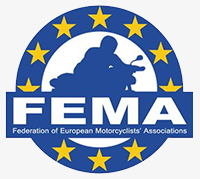 Useless impact assessment reinforces ABS proponents
Useless impact assessment reinforces ABS proponents
The EU parliamentary committee in charge of the motorcycle type approval regulation rejected the findings of an impact assessment it had ordered previously due to flawed data assessment. Contradicting the Committee’s vote the analysis concluded that mandating ABS for scooters and motorcycles with an engine displacement below 125cc was not cost-effective.
In the course of the decision making process of the EU regulation “on the approval and market surveillance of two- or three-wheeled vehicles and quadricycles”, the Committee for Internal Market and Consumer Protection (IMCO) of the European Parliament decided to expand mandatory Anti-lock Braking Systems (ABS) to new scooters and motorcycles from 51cc to 125cc (A1 category vehicles). The European Commission had originally proposed the option to install either ABS or Combined Braking Systems (CBS) for this category of vehicles.
IMCO further agreed to commission a study to assess the potential effects of the most drastic changes resulting from its vote. Next to the extending of ABS provisions the impact assessment, carried out by the British consultancy London Economics, aimed at shedding light on the cost-benefit of modifying On Board Diagnostics requirements and changing the timetable for emission standards for the application of the provisions.
Good results based on deficient analysis
FEMA and its member associations as well as the Association of Motorcycle Manufacturers in Europe (ACEM) oppose mandatory ABS for the A1 category based on the reason that for this group of vehicles CBS performs equally in terms of safety but is less costly then ABS. With an average price of 2.800€ A1 motorcycles and scooters used to be an affordable means of transport for commuters from all social levels as well as the entry category for young riders. Having to add the estimated average of 500€ per unit due to the installation of ABS would result in an average price increase of 16% for these vehicles.
Now the results of the impact assessment have indicated that for all the three IMCO decisions assessed, ABS for A1, On Board Diagnostics and the amended timetable for emission limits, the costs outweighed the benefits. Especially for mandatory ABS the costs seemed disproportionately high.
Unfortunately, the consultants of London Economics did not seem to have invested special efforts into quantifying the costs and benefits of these measures. Especially with regard to ABS, the most controversial issue, instead of thoroughly investigating all costs from production to adaptation and installation and not least maintenance, London Economics simply relied on the figure given by ACEM: 500€.
FIA, the umbrella organisation of car drivers’ clubs, immediately stated ABS FOR MOTORCYCLES: FIA DISAPPOINTED WITH FLAWED COST-BENEFIT ANALYSIS. And on Tuesday, 28 February, due to apparent shortcomings, the vast majority of the members of IMCO agreed to not take the results of the impact assessment into account at all. Therefore IMCO is going to stick to its call for mandating ABS for all powered two wheelers exceeding 51cc.
How not to spend money and how to calculate costs
FEMA is seriously wondering about the amount of taxpayers money spent for an impact assessment, whose preparation had taken over two months, which at the end is not being taken into account by anybody. As ACEM points out the stated figure of 500€ is not based on pure guesswork but could have been analysed thoroughly and convincingly:
“ACEM wishes to underline the following manufacturers’ costs per ABS system fitted/per individual vehicle:
- Manufacturers’ costs for additional hardware sourcing (e.g. pump, phonic wheel, CPU, wheel sensors, additional hoses, electric wiring, etc) start at 200€ for a basic ABS system. More complex systems can reach more than double, up to 500€. Smaller motorcycles, equipped with drum brakes, will even require changing the wheels, further increasing the costs.
- Manufacturers’ costs for application (e.g. adjustment of the function to the specific motorcycle model) will vary, depending on the complexity of the system and on the foreseen number of vehicle units sold over the model’s commercial lifetime. This cost can be estimated on average at 30€ per vehicle. In case of below-average-volumes production, all costs will be much higher.
Total costs to install ABS for manufacturers’ start therefore at 230€ per vehicle for the most basic systems, with large variations depending on volumes. These translate currently into consumer costs from 400€ to 1000€, with an average around 500€.
Whilst ACEM can agree that economies of scale and competition will to some extent contribute to reducing these costs, the magnitude of this future expected reduction should remain realistic. Motorcycle average production is much lower than car average production and is insufficient to trigger the economies of scale announced by some stakeholders. CBS systems also have varying degrees of complexity, but on average their costs can be estimated to be approximately 50% of those for ABS.”
Parliament vs Council
It becomes apparent that the majority of member states are not willing to support mandatory ABS for A1 vehicles therefore Council is expected to oppose the measure. Currently IMCO Rapporteur Wim van de Camp is trying to find a compromise between Council and EU Parliament and irrespective of the success of these so called trilogue discussions (the third party being the Commission who acts as advisor) there is still a chance that the Plenary of the EU Parliament finally votes against ABS despite the recommendation of IMCO.
And if not the legislative process is likely to go into second reading which would slow down implementation dates considerably. The more ambitious timetables IMCO was bringing forward could then become obsolete again. Finally nobody would benefit since manufacturers had to bear an extensive period of uncertainty which usually tends to hamper innovation.
The position of FEMA on EU motorcycle type approval – Click Here pdf
Join FEMA on Facebook – Click Here
Original Source: FEMA – Federation of European Motorcyclists Associations
Comment to this article on Right To Ride EU – Click Here
.
.


